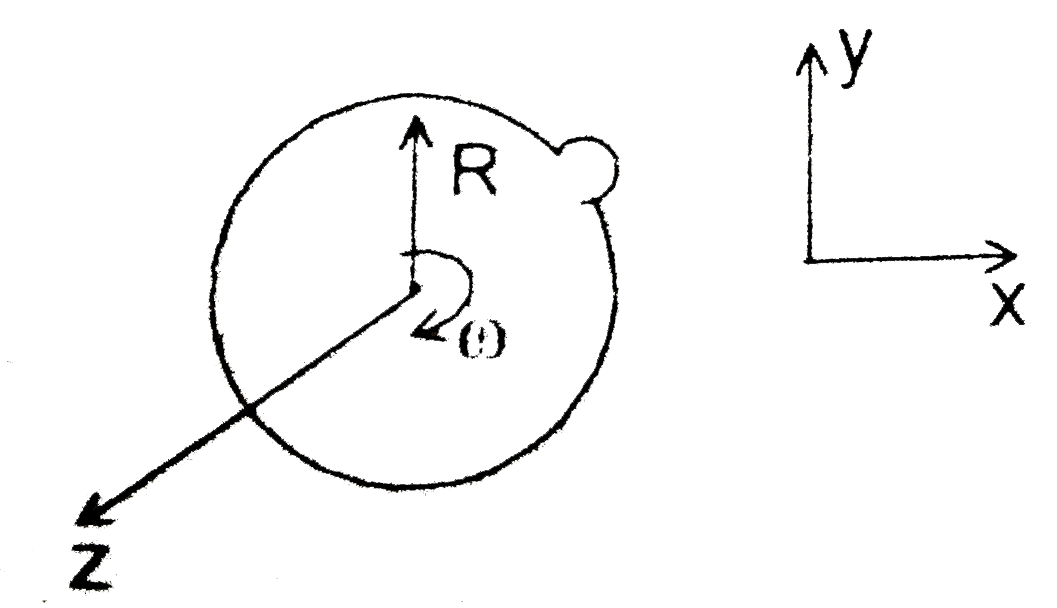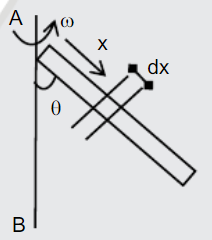A body rotating with angular velocity ω stops after rotating for 2 sec. The torque necessary for this is?
Iω2
2Iω
Iω
Iω22
The correct Answer is:A
To solve the problem of finding the torque necessary to stop a body rotating with an angular velocity ω after 2 seconds, we can follow these steps:
Step 1: Understand the problem
We know that the body is rotating with an initial angular velocity ω and needs to come to a stop (final angular velocity ωf=0) in a time duration of t=2 seconds.
Step 2: Use the angular motion equation
We can use the first equation of angular motion, which relates initial angular velocity, final angular velocity, angular acceleration, and time:
ωf=ωi+αt
Where:
- ωf = final angular velocity (0 in this case)
- ωi = initial angular velocity (ω)
- α = angular acceleration
- t = time (2 seconds)
Step 3: Substitute the known values
Substituting the known values into the equation:
0=ω+α⋅2
Step 4: Solve for angular acceleration α
Rearranging the equation to solve for α:
α⋅2=−ω
α=−ω2
The negative sign indicates that the angular acceleration is in the opposite direction to the initial angular velocity.
Step 5: Relate torque to angular acceleration
The torque τ required to produce an angular acceleration α is given by the equation:
τ=Iα
Where I is the moment of inertia of the body.
Step 6: Substitute α into the torque equation
Substituting the expression for α into the torque equation:
τ=I(−ω2)
Thus, the magnitude of the torque required to stop the body is:
τ=Iω2
Final Answer
The torque necessary for the body to stop after 2 seconds is:
τ=Iω2
We know that the body is rotating with an initial angular velocity ω and needs to come to a stop (final angular velocity ωf=0) in a time duration of t=2 seconds.
We can use the first equation of angular motion, which relates initial angular velocity, final angular velocity, angular acceleration, and time:
ωf=ωi+αt
Where:
- ωf = final angular velocity (0 in this case)
- ωi = initial angular velocity (ω)
- α = angular acceleration
- t = time (2 seconds)
Substituting the known values into the equation:
0=ω+α⋅2
Rearranging the equation to solve for α:
α⋅2=−ω
α=−ω2
The negative sign indicates that the angular acceleration is in the opposite direction to the initial angular velocity.
The torque τ required to produce an angular acceleration α is given by the equation:
τ=Iα
Where I is the moment of inertia of the body.
Substituting the expression for α into the torque equation:
τ=I(−ω2)
Thus, the magnitude of the torque required to stop the body is:
τ=Iω2
The torque necessary for the body to stop after 2 seconds is:
τ=Iω2
Topper's Solved these Questions
- SYSTEM OF A PARTICLES & ROTATIONAL MOTIONBOOK - VMC MODULES ENGLISHCHAPTER - SYSTEM OF A PARTICLES & ROTATIONAL MOTIONEXERCISE - IN-CHAPTER EXERCISE F
10 Videos
- SYSTEM OF A PARTICLES & ROTATIONAL MOTIONBOOK - VMC MODULES ENGLISHCHAPTER - SYSTEM OF A PARTICLES & ROTATIONAL MOTIONEXERCISE - IN-CHAPTER EXERCISE D
10 Videos
- SIMPLE HARMONIC MOTION BOOK - VMC MODULES ENGLISHCHAPTER - SIMPLE HARMONIC MOTION EXERCISE - 7-previous year question
46 Videos
- SYSTEM OF PARTICLES AND ROTATIONAL MOTIONBOOK - VMC MODULES ENGLISHCHAPTER - SYSTEM OF PARTICLES AND ROTATIONAL MOTIONEXERCISE - IMPECCABLE
56 Videos
Similar Questions
Knowledge Check
A disc is rotating with angular velocity ω. A force F acts at a point whose position vector with respect to the axis of rotation is r. The power associated with torque due to the force is given by
A(→r×→F).→ωB(→r×→F)×→ωC→r.(→F×→ω)D→r×(→F.→ω)
A disc is rotaing with an angular velocity ω0. A constant retarding torque is applied on it to stop the disc. The angular velocity becomes ω02 after n rotations. How many more rotations will it make before coming to rest ?
View SolutionA disc is rotating with angular velocity ω. A force F acts at a point whose position vector with respect to the axis of rotation is r. The power associated with torque due to the force is given by
View Solution
A small pulse is generated on a ring rotating with constant angular velocity ω as shown in the figure. Then the speed of pulse with respect to ground.
View SolutionWhat is the angular velocity of a particle lying on the axis of rotation ?
View SolutionWhat is the angular velocity of a particle lying on the axis of rotation ?
View SolutionA cylindrical vessel of radius r containing a liqiud is rotating about a vertical axis through the centre of circular base, If the vessel is rotating with angular velocity ω then what is the difference of the heights of liquid at centre of vessel and edge?
View SolutionCalculate the instantaneous power of a body rotating with angular velocity of 20rad/s−2, when an external torque of 5Nm is applied to it.
Hint : P=τω.
View Solution

